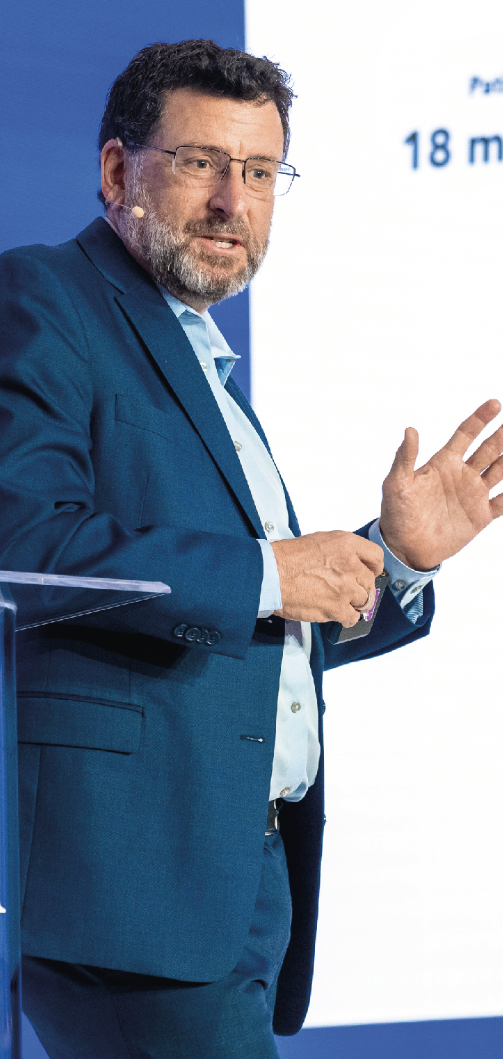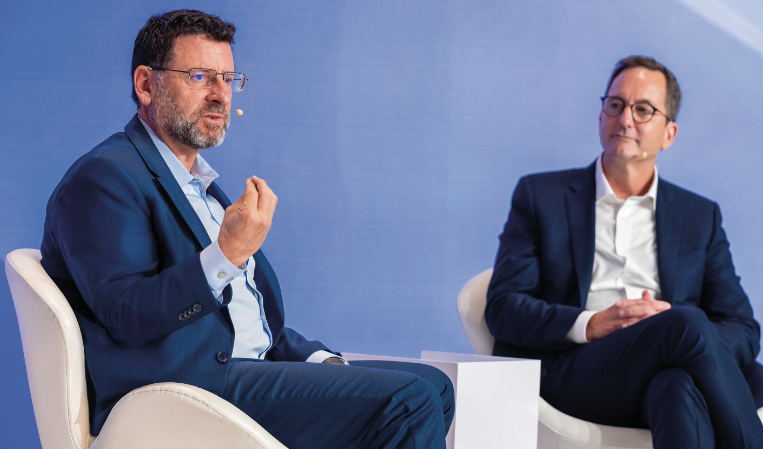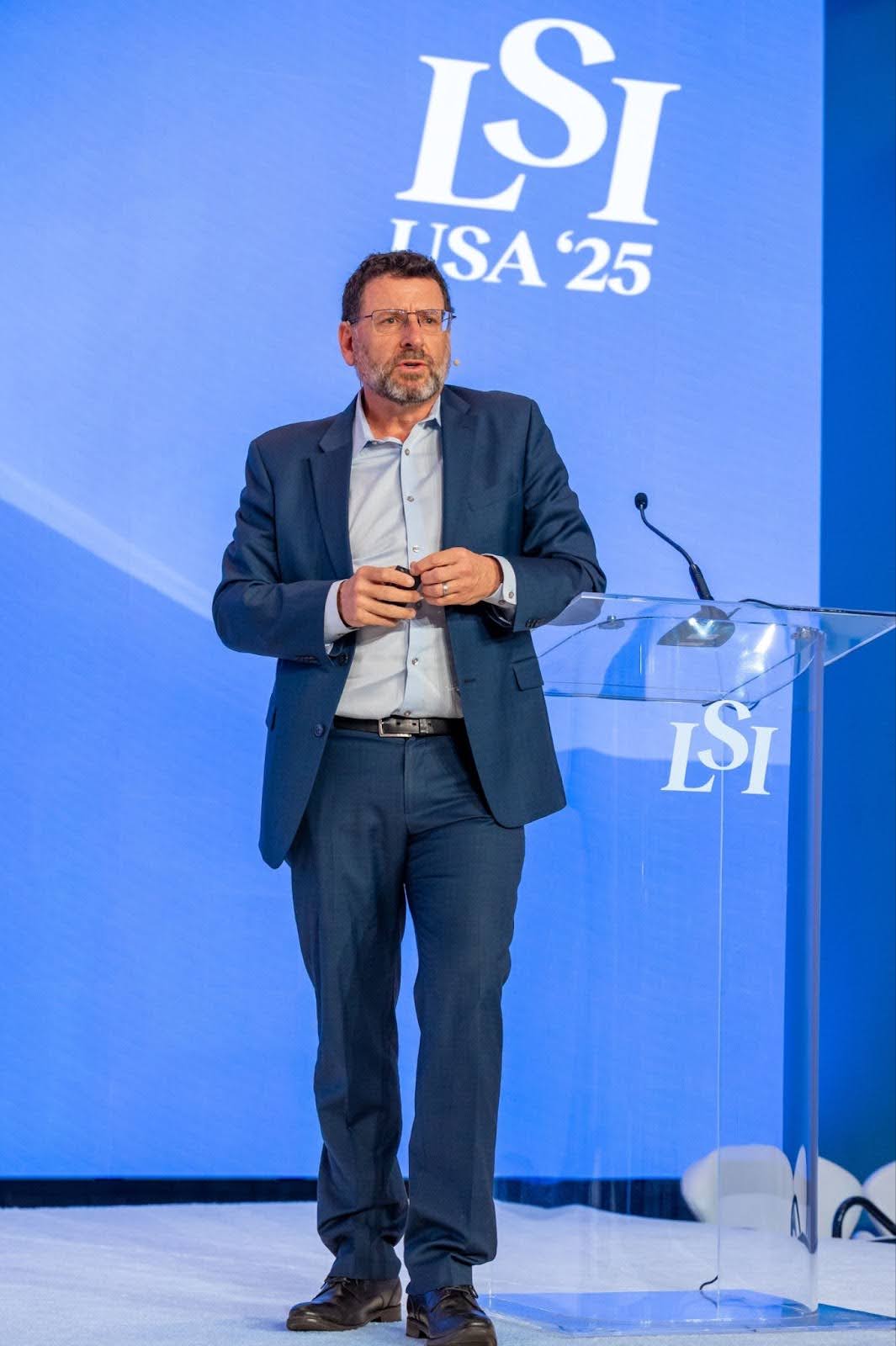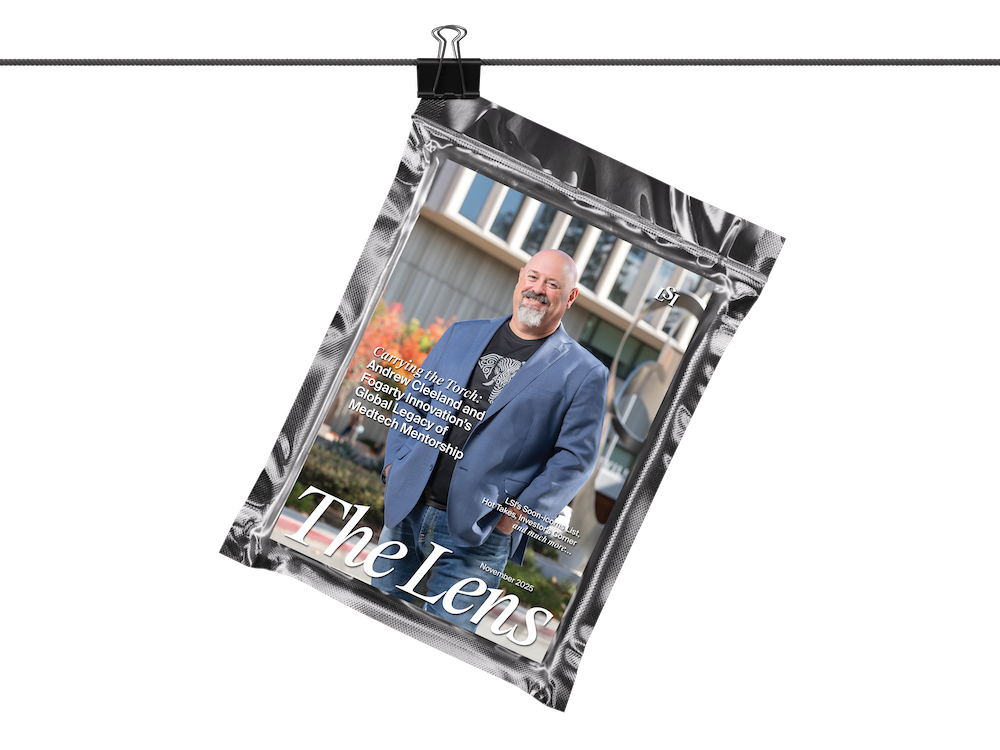
The evolution of Intuitive Surgical from a small Silicon Valley startup into a global leader in robotic-assisted surgery is more than a story of technological progress—it’s a masterclass in mission-driven innovation, long-term leadership, and relentless focus on clinical impact. At the helm of this transformation for more than a decade is CEO Gary Guthart. Under his leadership, Intuitive has not only pioneered the category of surgical robotics, but fundamentally reshaped what’s possible in the OR and beyond.
During a keynote presentation at LSI USA ‘25 in Dana Point, CA and a follow-up one-on-one interview with The Lens, Guthart reflected on Intuitive’s journey, its market leader momentum, and the bold new frontiers that lie ahead. His insights reveal not only what it takes to lead in the medical robotics space but also how to build a sustainable healthcare innovation ecosystem centered on patient outcomes, clinician experience, and equitable access.
A Career Built on Curiosity and Purpose
Guthart’s path into medical robotics didn’t begin with a business plan, but with a question. How can we better solve hard problems in healthcare?
“I’ve been in technology really my whole life,” Guthart shared during the LSI interview. “I started as a math and science major growing up. I found my way into surgical robots in 1993. It was one of about five research teams in the world doing surgical robots at the time. That group had been founded at Stanford Research Institute in Menlo Park. I was a young mathematician, and when I saw a demo of their early prototype, it just lit my imagination.”
That initial spark grew into a decades-long commitment. Guthart joined Intuitive as the 11th employee and 10th engineer, drawn not only by the breakthrough potential of the technology but also by the need it addressed.
“If you had asked at the time if I would have anticipated how deeply our systems would permeate into the ecosphere, I probably would not have had the imagination to think it through,” he says. “I think that the need part, the visceral need, you could tell was really clear from the very beginning. Even in 1993, even with these really primitive prototypes, I was like, ‘Wow, this is crazy better.’ And that fire, this could matter, that has persisted all the way through.”
“Even in 1993, even with these really primitive prototypes, I was like, ‘Wow, this is crazy better.’ And that fire, this could matter, that has persisted all the way through.”
Guthart’s leadership style is rooted in empathy, discipline, and strategic clarity. He credits mentors like Fred Moll and Lonnie Smith with showing him what it means to lead shoulder to shoulder.
He also believes in transparency—especially with shareholders.
“From day one, we’ve messaged unwavering belief in the long term, paired with honesty about near-term challenges. That builds trust.”
The elegance and impact of Intuitive’s technology today reflects the realization of the spark that Guthart felt more than three decades ago, and helped to nurture.
From Bold Idea to Clinical Standard
Intuitive’s da Vinci Surgical System, with the first-generation system cleared by the FDA in July 2000, and the fifth-generation da Vinci 5 cleared in March 2024, has ushered in a new era of minimally invasive surgery.
“It started with a clear mission,” explains Guthart. “We knew we were part of the surgical family. Robotic-assisted surgery was a natural extension of minimally invasive techniques. Surgeons who were champions of laparoscopy understood the potential immediately.”

“The right team was pulled together,” says Guthart. “The right mix of skills. The mix of entrepreneurs, professional leadership, and the early investors. They were patient, because these things take a long time. We had really engaged leadership, leaders who were shoulder to shoulder with people doing the work, and deeply committed to the mission.”
That clarity helped Intuitive navigate early challenges as a pioneer opening a new frontier in medicine, including technical hurdles, regulatory complexities, and clinical skepticism. The leadership team assembled a multidisciplinary group of engineers, physicians, and entrepreneurs, backed by early investors who believed in the long-term vision.
But it wasn’t just about product development, says Guthart. A unique cultural DNA took hold early on—one that emphasized an unrelenting commitment to patient outcomes.
“We had really engaged leadership, leaders who were shoulder to shoulder with people doing the work, and deeply committed to the mission.”
“And so that combination, of the right mission, the right mix of talent, and then a culture centered around a deep commitment and teamwork. Those have been the things that have been pillars of strength for the company,” he continues.
Impact that’s Global, and Personal
The impact of robotic-assisted surgery has been profound. Over 17 million procedures have been performed using Intuitive systems, with more than 2.7 million in the past year alone. Today, Intuitive supports care in more than 70 countries, across multiple clinical specialties.
But for Guthart, the impact is also deeply personal. During his keynote, he shared the story of his mother, a retired schoolteacher who faced a long and traumatic diagnostic and treatment journey after a suspicious lung nodule was detected.
“She went through a year of follow-up scans, a failed manual bronchoscopy, a diagnostic VATS [video-assisted thoracic surgery] procedure, and a full lobectomy,” Guthart recounted. “Six days in the ICU, two additional procedures to clear her lungs… it was brutal. She lived, and to the oncologist, that’s a win. But it was a tough run.”
He then reiterates a case several years later, with a similar patient—also a retired schoolteacher, also a prior smoker—who was treated with Intuitive’s Ion Endoluminal System. In three weeks, she had a biopsy, diagnosis, and definitive surgery in a single event. She was home within 48 hours.
It’s rare to make that kind of change in medicine. But it’s possible.”
“The difference in time was a factor of ten,” Guthart said. “That’s what we’re trying to do. It’s rare to make that kind of change in medicine. But it’s possible.”
Innovation with Intention: Da Vinci 5, SP, and Ion
The fifth-generation da Vinci 5 is a testament to Intuitive’s commitment to continuous innovation, Guthart explains. The latest system incorporates new computational technologies, force-sensing instruments, and higher surgeon autonomy.
“We’re proud of it. It brings some really key capabilities to customers that are the result of a lot of years of learning,” he says. “It’s both iteration that is responding to their feedback, as well as disruptive innovation that has never been brought to market before.”
“First, it’s the highest precision system we’ve brought to market, and precision matters,” he continues. “How much fidelity is there in following surgeons’ ideas and commands. The second key capability is that we’re taking advantage of next-generation imaging and creating just spectacular 3D images, which we’ve been doing for a long time. This takes it to another level for us as well.
We’ve also learned a lot about surgeon workflow and what it takes to coordinate the team that’s in the room. The system leads to less stress and strain on the team and higher efficiency, greater throughput. The ergonomics are better. The goal is to improve workflow, reduce fatigue, and deliver even better outcomes.”
A standout innovation with da Vinci 5 is the system’s ability to measure and reflect tissue force in real time—enabling a new era of surgical data science, says Guthart.
“For the first time, we can quantify force during surgery,” he says. “We’ve introduced something called Force Feedback technology, that allows surgeons to feel subtle forces exerted on tissue during surgery, something not offered by other surgical technologies. We’ve put tiny little sensors inside the body that sense contact forces with tissue, that surgeons can then measure and record so we can track what kind of forces are happening during surgery. But also they can feel it in their hands. So it’s both a tactile sense, a feeling sense, a haptic sense, and its measurement.”
Guthart explains that these capabilities are combined with enormous increases in processing power. “We use chips from our partner NVIDIA, and that set of processing power and new data sources allow surgeons to explore surgical technique in ways that have never been done before. We can now explore questions that go back to Halsted’s principles in the 1800s—how much force is too much? What does gentle surgery really mean in data terms, and in outcomes? That’s going to change things. I think it will really start to revolutionize surgery once again, in this sense from a surgical data science point of view, what makes great surgery as expressed in data. Revolutionizing surgery is an ongoing task. It’s not just one time revolutionized, it is ongoing.”

Revolutionizing surgery is an ongoing task. It’s not just one time revolutionized, it is ongoing.”
Alongside da Vinci 5, Intuitive’s da Vinci SP (Single Port) system is gaining global traction in narrow-access procedures such as head and neck surgeries. “SP is also a soft tissue platform and it enters the body differently and creates new opportunities for surgeons and technique,” says Guthart. “It’s also optimized for a single-incision surgery, where surgeons want to take a specimen out and make no other cuts in the body. We’ve seen really nice uptake where we have broad clinical clearances.” (As this issue of The Lens was going to press, Intuitive’s SP SureForm 45 surgical stapler system was FDA-cleared for use with its da Vinci SP system, spanning minimally invasive thoracic, colorectal, and urologic procedures. Intuitive notes that the SP SureForm 45 is built off the same technology as its multiport da Vinci counterpart, including systems to monitor tissue compression before and during stapling to ensure a secure hold and reduce the risk of damage.)
Guthart also highlighted Intuitive’s new Ion endoluminal system, a first-of-its-kind flexible robotic platform that allows interventionalists and surgeons to enter tortuous tubular structures such as the lung. Ion’s ultrathin, ultramaneuverable catheter allows clinicians to reach small lesions in all 18 segments of the lung with more reach, precision, and stability. The system, FDA-cleared in 2019, is now used in more than a quarter of all lung cancer diagnoses in the U.S. (Also see “Solving Wicked Problems at the Intersection of Healthcare and Technology - Insights from Intuitive Foundation’s Catherine Mohr, MD,” The Lens, February 2025.)
“Ion’s first application and indication has been in the lung, and we’ve seen great uptake with regard to navigation for lung biopsies,” says Guthart.
Data, AI, and the Future of Surgical Intelligence
While surgical robots remain the most visible manifestation of Intuitive’s innovation, Guthart is quick to clarify: “We don’t think of ourselves as a robotics company. Robots are tools—they’re dead things. What matters is helping our customers deliver better care.”
That philosophy is shaping Intuitive’s next frontier: surgical data science. By embedding sensors into instruments, leveraging cloud computing, and investing in advanced analytics, Intuitive is creating systems that don’t just perform—they learn. This is an exciting area because objective metrics in surgery haven’t really existed at scale, and the company’s robotic platform facilitates measurement of those. AI technology facilitates extracting clinically meaningful objective metrics that are interpretable by a surgeon around a particular surgical activity.
“We’ve been doing IoT for 15 years. Now we’re using that data to help care teams get better faster,” Guthart says. “We’re not interested in demo features that are easy to make but hard to validate. What matters is data that improves real-world decisions.”
He is also wary of AI hype. “Everyone’s weighing their data sets, but the differentiator isn’t mass—it’s quality. High-quality, differentiated data plus the ability to validate and integrate it into workflows. That’s where the real value is.”
High-quality, differentiated data plus the ability to validate and integrate it into workflows. That’s where the real value is.”
The Quintuple Aim: A North Star for Healthcare Impact
Under Guthart’s leadership, Intuitive has adopted the Quintuple Aim, a framework that prioritizes better patient outcomes, better care team experiences, better patient experiences, lower total cost per patient episode, and greater access to care.
These aren’t just aspirational goals. Intuitive has more than 43,000 peer-reviewed clinical studies—with 4,000+ added in just the last year—to measure its progress across all five aims.
“We measure ourselves in the language of the customer,” says Guthart. “Well-run robotics programs aren’t just clinically valuable. They’re often the most profitable thing a hospital does. That surprises people, but the data is clear.”
“Well-run robotics programs aren’t just clinically valuable. They’re often the most profitable thing a hospital does. That surprises people, but the data is clear.”
The Power of Staying Curious—and Humble
Despite leading a company with a $100+ billion market cap and commanding over 10,000 installed systems globally, Guthart maintains a mindset more akin to a researcher than a CEO.
“I wasn’t seeking a title. I wasn’t chasing compensation,” he says. “I was chasing the question: what can we do better?”
His advice to other innovators? “Stay mission-focused. Align your team, your customers, and your shareholders around a clear set of objectives. And always, always, start with the end in mind. Who are the beneficiaries of your work? Don’t fall in love with the technology. Fall in love with the problem to solve. Then assemble a team of people who can deliver on that mission, of customers who are excited by that mission, and of shareholders who see the vision and are aligned to the mission and objectives. If you can pull those together, you have the opportunity to make that lasting—and the world needs it.”
“Don’t fall in love with the technology. Fall in love with the problem to solve.”
Intuitive’s future will be defined by this mindset. The company is investing heavily in organic R&D, partnerships, and a venture portfolio focused on surgical intelligence, diagnostics, and digital health. (Look for a feature article on Intuitive Ventures in an upcoming issue of The Lens.)
And while it may seem like Intuitive has reached the summit, Guthart sees only more hills to climb.
“Every patient deserves the best possible outcome,” he says. “If we ask ourselves the question, what interrupts that, that’s where the opportunity lies. If we stay focused on that, we’ll continue to add value.”
Innovation Matters
For Intuitive, innovation matters, and Guthart explained this central theme eloquently.
“You look to what needs to be done, rather than what has been done,” he says. “Sometimes you can look backwards with pride, but pride can get in the way. What you really want to do is look forward. What is the remaining opportunity? And the remaining opportunity is enormous.
I think what drives innovation is the goal of making the healthcare ecosystem centered around better patient outcomes. And that is true all over the place. You can see opportunities just about anywhere you look. That includes things that are currently being done with our products and systems today. We don’t look at them and say, well, we’re done. We look at things like cancer procedures and urology and say, hey, we can be more precise. We can do better at reducing positive surgical margins. We can help surgeons get better functional outcomes.
We can also look outside of the things we do today and say, where do our skills and attributes allow us to help a different class or set of surgical procedures and a different population of patients. We have a real opportunity to help more patients in more places. I think that is a decades-long opportunity. I don’t think it goes away.”
Changing the Face of Surgery
Guthart remains committed to the idea that every patient deserves the best possible surgical outcome. By continuing to push technological boundaries, foster a culture of innovation, and prioritize patient well-being, Intuitive is poised to shape the next era of medical technology.
What’s more, reverberation from the company’s impact extends far beyond the operating room.
Intuitive has forever changed the face of surgery, and led to shift change in the medtech arena, setting a high bar for robotic-assisted surgery into the future and spurring the next wave of innovation and strategic investment. The company has played a major role in establishing the regulatory and reimbursement framework for robotic surgery systems, and reshaping hospital economics and reimbursement to demonstrate the long-term value of these technologies.
And when asked what keeps him pushing forward three decades in, Guthart’s answer is simple: “We’re not done. There’s so much more to do. Revolutionizing surgery isn’t a one-time thing. It’s ongoing. It’s the work.”
Related Content in The Lens:
- COVER STORY: Solving Wicked Problems at the Intersection of Healthcare and Technology - Insights from Intuitive Foundation’s Catherine Mohr, MD (February 2025 issue)
- Market Dive: GI Endoscopy Devices (January 2025 issue)
- Power Moves (January 2025 issue)

Gary S. Guthart, PhD, is chief executive officer at Intuitive and a member of the Board of Directors, roles he has held since 2010. He draws from more than 25 years of medical, engineering, scientific, and management experience.
Guthart joined the company as part of the first engineering team in 1996 as a control systems analyst. He was promoted to vice president of engineering in 1999, senior vice president of product operations in 2002, and four years later, he was appointed president and chief operating officer.
Before joining Intuitive, Guthart was part of the core team developing foundational technology for computer-enhanced surgery at SRI International (formerly Stanford Research Institute), a renowned nonprofit scientific research organization. While at SRI, he also developed algorithms for vibration and acoustic control of large-scale systems. Guthart’s first scientific experience came early in his career in a human factors lab at NASA, supporting a team studying human performance assessment of pilots.
Guthart is on the Board of Directors for Illumina.
Guthart received a BS in engineering from the University of California, Berkeley. He earned an MS and a PhD in engineering science from the California Institute of Technology.
Gary S. Guthart, PhD, is chief executive officer at Intuitive and a member of the Board of Directors, roles he has held since 2010. He draws from more than 25 years of medical, engineering, scientific, and management experience.
Guthart joined the company as part of the first engineering team in 1996 as a control systems analyst. He was promoted to vice president of engineering in 1999, senior vice president of product operations in 2002, and four years later, he was appointed president and chief operating officer.
Before joining Intuitive, Guthart was part of the core team developing foundational technology for computer-enhanced surgery at SRI International (formerly Stanford Research Institute), a renowned nonprofit scientific research organization. While at SRI, he also developed algorithms for vibration and acoustic control of large-scale systems. Guthart’s first scientific experience came early in his career in a human factors lab at NASA, supporting a team studying human performance assessment of pilots.
Guthart is on the Board of Directors for Illumina.
Guthart received a BS in engineering from the University of California, Berkeley. He earned an MS and a PhD in engineering science from the California Institute of Technology.
For more insights like this, subscribe to The Lens medtech magazine today.
17011 Beach Blvd, Suite 500 Huntington Beach, CA 92647
714-847-3540© 2025 Life Science Intelligence, Inc., All Rights Reserved. | Privacy Policy







